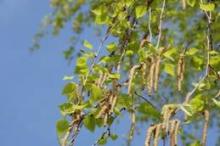ORLANDO – Asthma-related visits to emergency departments spike in the spring, when grass and tree pollen levels are at their highest, according to investigators in two separate studies presented here at the annual meeting of the American Academy of Allergy, Asthma, and Immunology.
Over a 9-year period, asthma-related ED visits at two hospitals in the Bronx borough of New York City tended to peak in May, coinciding with high tree pollen levels, reported Dr. Jennifer Toh and colleagues from Albert Einstein College of Medicine, New York, and Southern Methodist University in Dallas.
On the other side of the world in Australia, ED visits for asthma care coincided with high grass pollen levels in November and early December, spring months in the antipodean calendar, reported Dr. Bircan Erbas of La Trobe University in Melbourne and colleagues.
"We have a growth corridor in Melbourne which has been predominantly used for grazing of cattle and sheep, and we’ve seen increases in admissions for asthma and allergies," Dr. Erbas said in an interview.
She noted that following several days of high winds and severe thunderstorms in Melbourne in November 2003, there was a peak in ED attendance of 70 visits per day, "consistent with thunderstorm-associated asthma related to the preceding extreme grass pollen days and strong winds."
In the Bronx, where there is a high prevalence of asthma, tree pollen spikes in the Northern Hemisphere’s spring seem to be related to increases in asthma-related ED visits, Dr. Toh said in an interview.
Dr. Toh and colleagues looked at day-by-day asthma-related emergency department visits, as identified by ICD (International Classification of Disease) codes, at two hospitals in the Bronx. They then matched those data to daily pollen counts collected at the nearest pollen trap, located in Armonk, N.Y., about 27 miles north of New York City.
From 2001 through 2008, the investigators noted distinct peaks of increased ED visits for asthma, one each in January, May, and November.
"For most of the years studied, the spring peak was most prominent and consistently overlapped with high tree pollen levels. In addition, our regression analysis [of excess vs. average daily asthma ED visits] revealed that the largest excess asthma-related emergency department visits consistently overlapped the larger tree pollen levels during the month of May every year," they wrote in a poster presentation.
The investigators did not have data on the type of tree pollen.
"I think that in the entire Northeast, tree pollen is the most relevant allergen in terms of severe seasonal allergies. We don’t have as many problems with grass or ragweed as we do with trees," said Dr. Bernard Silverman, of Mount Sinai Hospital in New York. Dr. Silverman commented on the study in an interview, but was not involved in it.
The height of the pollen traps and their distance from the city may have influenced the results, said another clinician not involved in the study. It is important when studying pollen levels to set pollen traps at the appropriate height for the question the investigators hope to address, said Dr. Karl-Christian Bergmann of Charité Hospital in Berlin. Traps lower to the ground are more useful for measuring the amount of pollen that individuals are likely to inhale at the local level, whereas as traps set at a height of about 15-25 m are more useful for gauging airborne pollen levels over a broader geographic area. Results also can be confounded by higher levels of airborne carbon particulates, such as those found in diesel exhaust, he said.
Dr. Erbas and colleagues noted that "lower levels of pollen may contribute to asthma symptoms, levels that are much lower than the current level of 50 g/m3 which is used as the trigger point for warning asthma patients to avoid nonessential outdoor activities and/or take additional asthma medication."
Both Dr. Toh’s and Dr. Erbas’ studies were supported by the participating institutions. Both clinicians reported having no relevant disclosures.



